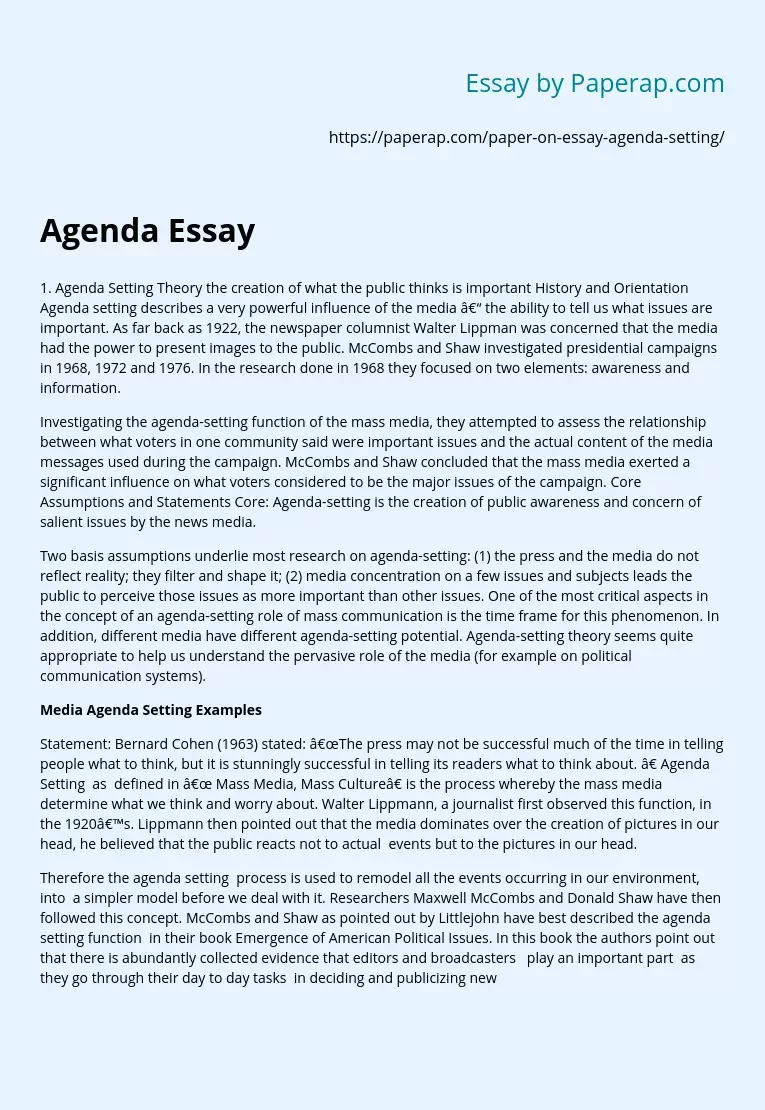Agenda Setting Theory in Mass Media
1. Agenda Setting Theory the creation of what the public thinks is important History and Orientation Agenda setting describes a very powerful influence of the media – the ability to tell us what issues are important. As far back as 1922, the newspaper columnist Walter Lippman was concerned that the media had the power to present images to the public. McCombs and Shaw investigated presidential campaigns in 1968, 1972 and 1976. In the research done in 1968 they focused on two elements: awareness and information.
Investigating the agenda-setting function of the mass media, they attempted to assess the relationship between what voters in one community said were important issues and the actual content of the media messages used during the campaign.
McCombs and Shaw concluded that the mass media exerted a significant influence on what voters considered to be the major issues of the campaign. Core Assumptions and Statements Core: Agenda-setting is the creation of public awareness and concern of salient issues by the news media.
Two basis assumptions underlie most research on agenda-setting: (1) the press and the media do not reflect reality; they filter and shape it; (2) media concentration on a few issues and subjects leads the public to perceive those issues as more important than other issues.
One of the most critical aspects in the concept of an agenda-setting role of mass communication is the time frame for this phenomenon. In addition, different media have different agenda-setting potential. Agenda-setting theory seems quite appropriate to help us understand the pervasive role of the media (for example on political communication systems).
Media Agenda Setting Examples
Statement: Bernard Cohen (1963) stated: “The press may not be successful much of the time in telling people what to think, but it is stunningly successful in telling its readers what to think about. ” Agenda Setting as defined in “ Mass Media, Mass Culture” is the process whereby the mass media determine what we think and worry about. Walter Lippmann, a journalist first observed this function, in the 1920’s. Lippmann then pointed out that the media dominates over the creation of pictures in our head, he believed that the public reacts not to actual events but to the pictures in our head.
Therefore the agenda setting process is used to remodel all the events occurring in our environment, into a simpler model before we deal with it. Researchers Maxwell McCombs and Donald Shaw have then followed this concept. McCombs and Shaw as pointed out by Littlejohn have best described the agenda setting function in their book Emergence of American Political Issues. In this book the authors point out that there is abundantly collected evidence that editors and broadcasters play an important part as they go through their day to day tasks in deciding and publicizing news. This impact of the mass media- the ability to effect cognitive change among among individuals, to structure their thinking- has been labeled the agenda-setting function of mass communication. Here may lie the most important effect of mass communication, its ability to mentally order and organize our world for us. In short, the mass media may not be successful in telling us what to think, but they are stunningly successful in telling us what to think about. (McCombs and Shaw, 5) The common assumption of agenda- setting is that the ability of the media to influence the visibility of events in the public mind has been apart of our culture for almost half a century. Therefore the concept of agenda setting in our society is for the press to selectively choose what we see or hear in the media. 2. Development Communication You must also know that communication is used as an empowerment tool. In other words, communication is used as a tool to facilitate the participation of people in development activities.
Knowledge and information are essential for people to successfully respond to the opportunities and challenges of social, economic and technological changes. But to be useful, knowledge and information must be effectively communicated to people. Millions of people in developing countries are excluded from a wide range of information and knowledge, with the rural poor in particular remaining isolated from both traditional media and new information and communication technologies which would improve their life. Here, in ‘development communication’, you see that there are two words- ‘development’ and ‘communication’.
By now, you know what communication means. You have also learnt that communication is a message understood or sharing of experience. When we refer to communication, in the context of development, we refer to various types of communication like interpersonal, group and mass communication. Now let’s try and understand the term ‘development’. It is not easy to define this as it depends on the context. Development is about change. It is about changing for the better. It could be about social or economic change for improvement or progress.
When we refer to development communication, it is about such communication that can be used for development. It is about using communication to change or improve something. Here we use different types of messages to change the socio-economic condition of people. These messages are designed to transform the behaviour of people or for improving their quality of life. Therefore, development communication can be defined as the use of communication to promote development. Those who write or produce programmes on issues related to development are called development communicators.
Role of a development communicator The development communicator plays a very significant role in explaining the development process to the common people in such a way that it finds acceptance. In order to achieve this objective a development communicator: – has to understand the process of development and communication; – should possess knowledge in professional techniques and should know the audience; – prepare and distribute development messages to millions of people in such a way that they are received and understood, accepted and applied.
Agenda Setting Theory in Mass Media. (2019, Dec 05). Retrieved from https://paperap.com/paper-on-essay-agenda-setting/

